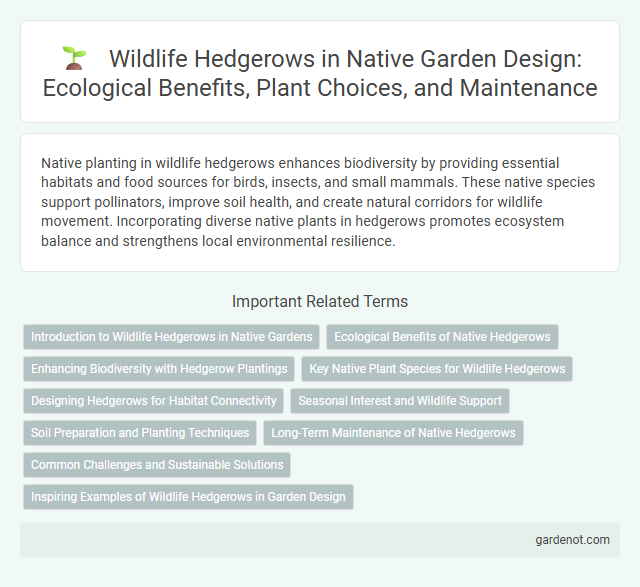Native planting in wildlife hedgerows enhances biodiversity by providing essential habitats and food sources for birds, insects, and small mammals. These native species support pollinators, improve soil health, and create natural corridors for wildlife movement. Incorporating diverse native plants in hedgerows promotes ecosystem balance and strengthens local environmental resilience.
Introduction to Wildlife Hedgerows in Native Gardens
Wildlife hedgerows in native gardens serve as vital corridors that support biodiversity by providing shelter, nesting sites, and food sources for birds, insects, and small mammals. Incorporating species such as native hawthorn, elderberry, and wild rose enhances habitat connectivity and promotes ecological balance. These living fences not only boost pollinator populations but also contribute to soil health and natural pest control within garden ecosystems.
Ecological Benefits of Native Hedgerows
Native hedgerows provide essential habitat and food sources for pollinators, birds, and small mammals, enhancing local biodiversity. Their deep root systems improve soil health by preventing erosion and promoting nutrient cycling. By offering natural corridors, these hedgerows support wildlife movement and ecosystem connectivity.
Enhancing Biodiversity with Hedgerow Plantings
Wildlife hedgerows planted with native species create vital habitats that support diverse bird, insect, and small mammal populations. These green corridors enhance ecosystem connectivity by linking fragmented habitats and providing food, shelter, and breeding sites. Strategically designed hedgerows increase pollinator presence and promote natural pest control, contributing to overall biodiversity conservation.
Key Native Plant Species for Wildlife Hedgerows
Key native plant species for wildlife hedgerows include hawthorn (Crataegus monogyna), blackthorn (Prunus spinosa), and holly (Ilex aquifolium), which provide crucial food and shelter for birds and insects. Elder (Sambucus nigra) and rowan (Sorbus aucuparia) support pollinators and fruit-eating mammals, enhancing biodiversity. Incorporating dog rose (Rosa canina) and hazel (Corylus avellana) further enriches habitat complexity and seasonal resource availability for native wildlife.
Designing Hedgerows for Habitat Connectivity
Designing wildlife hedgerows for habitat connectivity enhances biodiversity by creating continuous corridors that enable safe movement for native species. Incorporating dense native shrubs such as hawthorn, blackthorn, and hazel supports nesting birds, small mammals, and beneficial insects, promoting ecosystem resilience. Strategic placement along field margins and waterways maximizes ecological linkages between fragmented habitats, increasing genetic diversity and reducing wildlife mortality.
Seasonal Interest and Wildlife Support
Native wildlife hedgerows provide year-round seasonal interest through diverse flowering periods, vibrant fall foliage, and winter berries. These hedgerows support local wildlife by offering essential habitats, food sources, and shelter for birds, pollinators, and small mammals throughout changing seasons. Planting species such as serviceberry, dogwood, and elderberry enhances ecological connectivity and boosts biodiversity in native landscapes.
Soil Preparation and Planting Techniques
Wildlife hedgerows thrive best when soil is well-prepared through thorough tilling and incorporation of organic matter to improve aeration and nutrient availability. Selecting native shrub species with deep root systems enhances soil stabilization and water retention while supporting local fauna. Planting techniques such as spacing plants to allow natural growth patterns and using mulch to retain moisture promote healthy establishment and long-term biodiversity benefits.
Long-Term Maintenance of Native Hedgerows
Long-term maintenance of native wildlife hedgerows involves regular monitoring and selective pruning to promote healthy growth and biodiversity. Maintaining diverse plant species within the hedgerow supports a wide range of wildlife, including pollinators, birds, and small mammals. Effective management also includes controlling invasive species and ensuring soil health to sustain the ecological balance over time.
Common Challenges and Sustainable Solutions
Wildlife hedgerows often face challenges such as invasive species, limited native plant diversity, and habitat fragmentation. Sustainable solutions include planting a mix of native shrubs and trees to enhance biodiversity, using organic mulch to improve soil health, and creating continuous corridors to support wildlife movement. Regular monitoring and community involvement are essential to maintain hedgerow vitality and ecosystem balance.
Inspiring Examples of Wildlife Hedgerows in Garden Design
Wildlife hedgerows composed of native plants provide critical habitat and food sources for pollinators, birds, and small mammals, promoting biodiversity in residential gardens. Examples like mixed-species hedgerows featuring hawthorn, blackthorn, and hazel create dense shelter and seasonal berries that attract a variety of wildlife. Incorporating layered native shrubs and groundcovers within hedgerows enhances ecological connectivity while offering visual interest and year-round structural diversity in garden design.
Wildlife hedgerow Infographic

 gardenot.com
gardenot.com